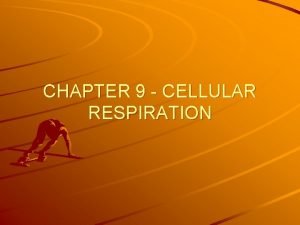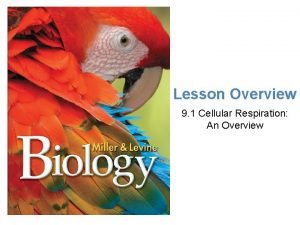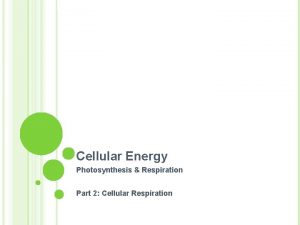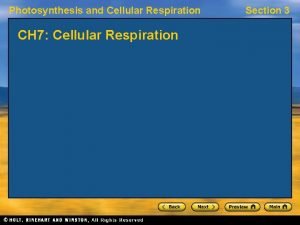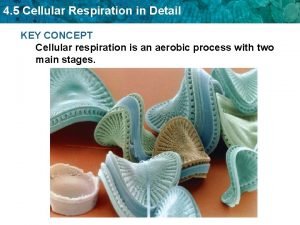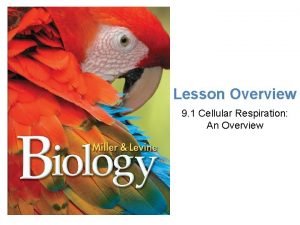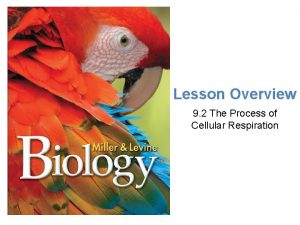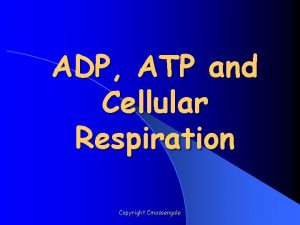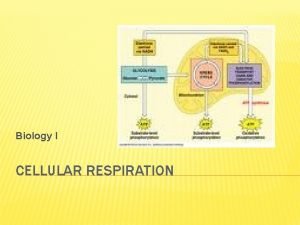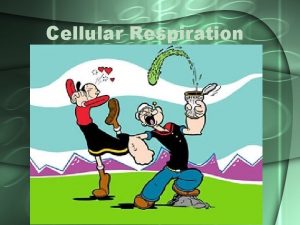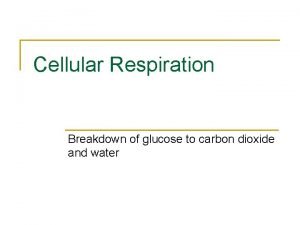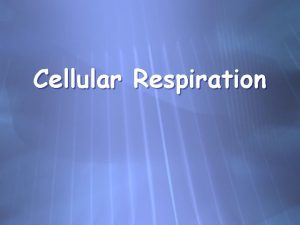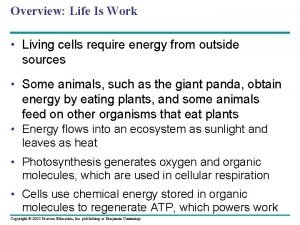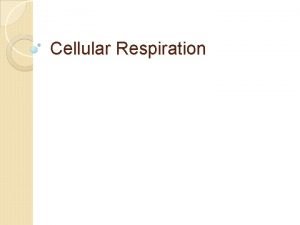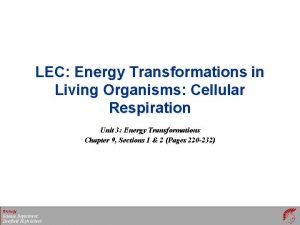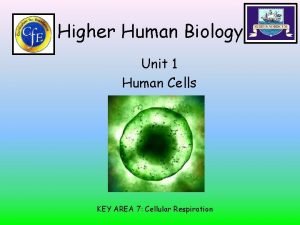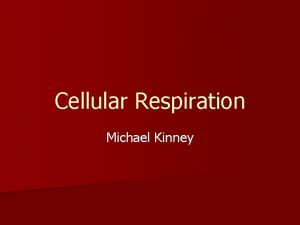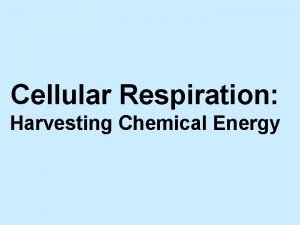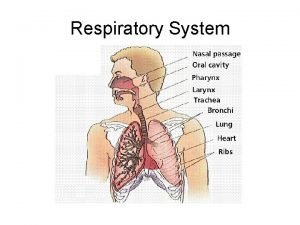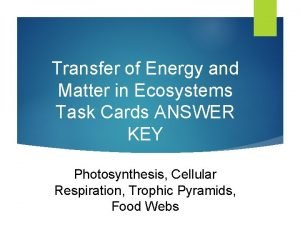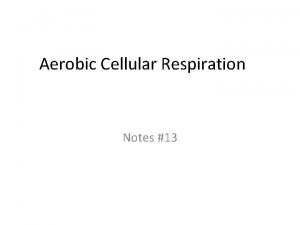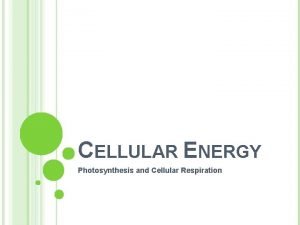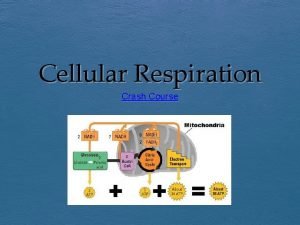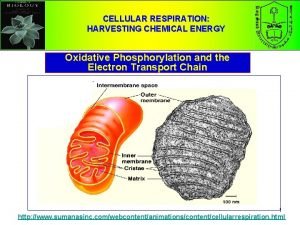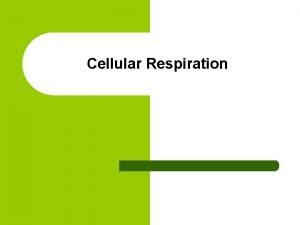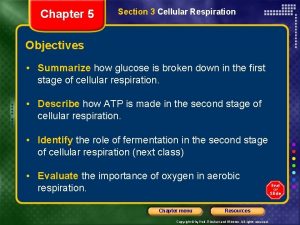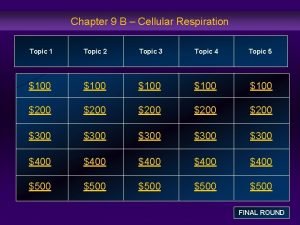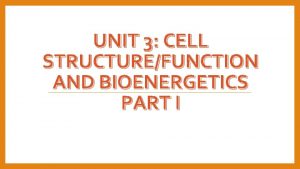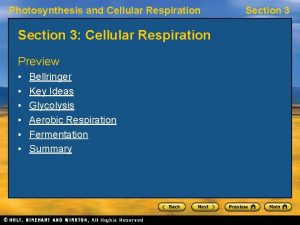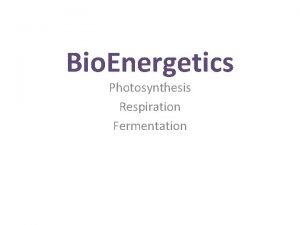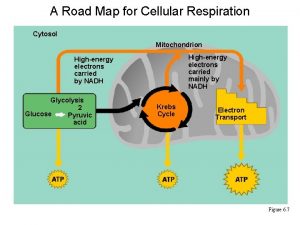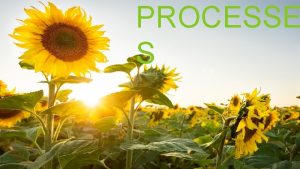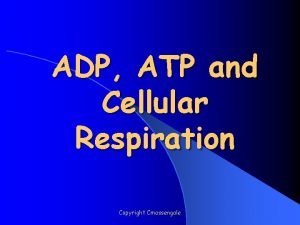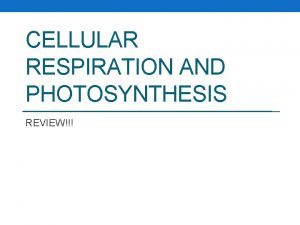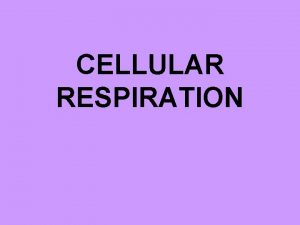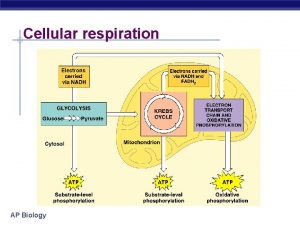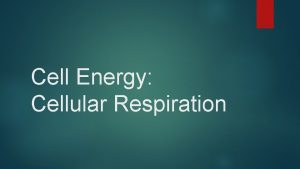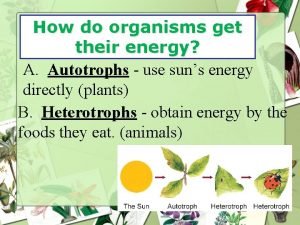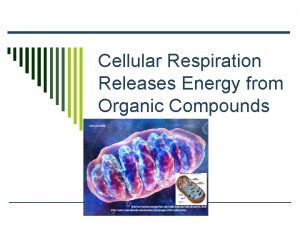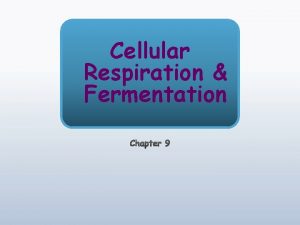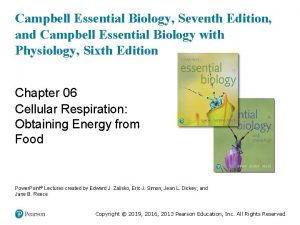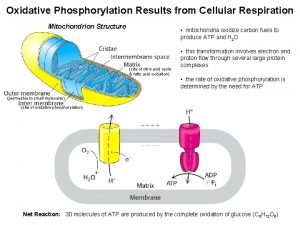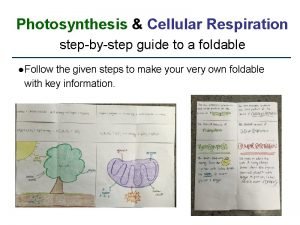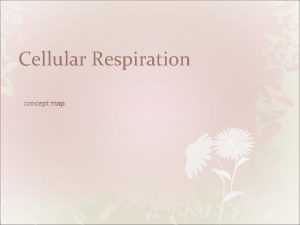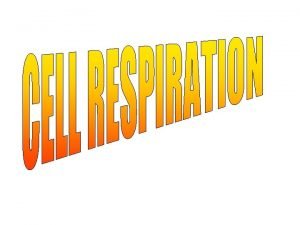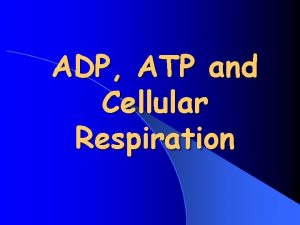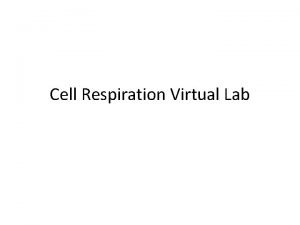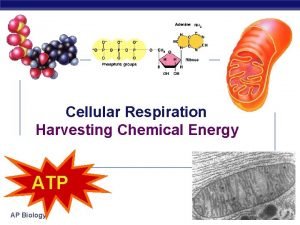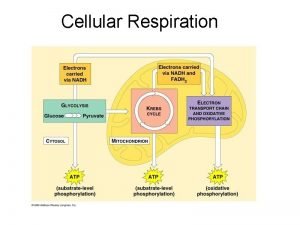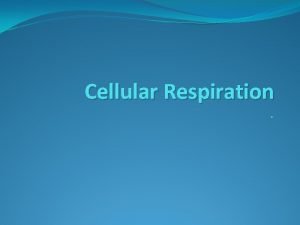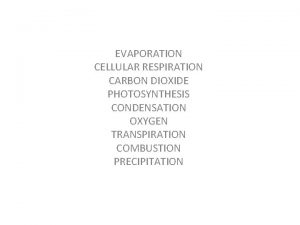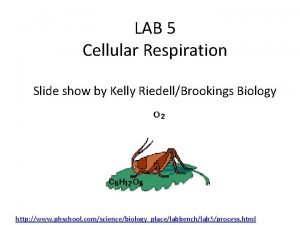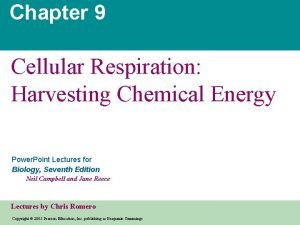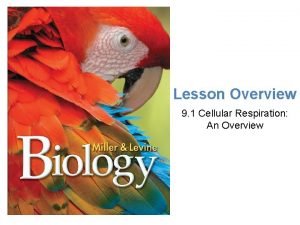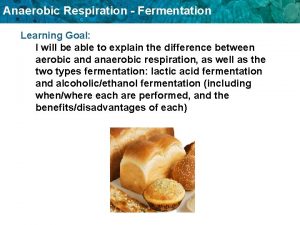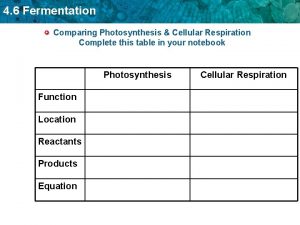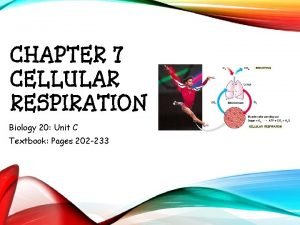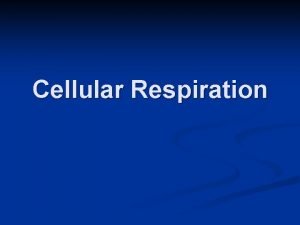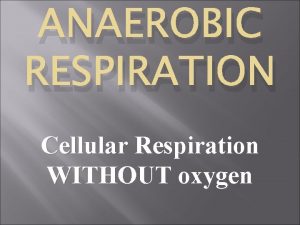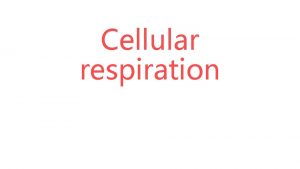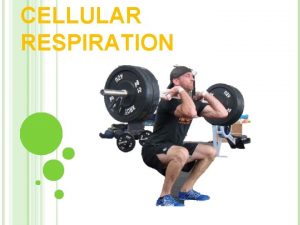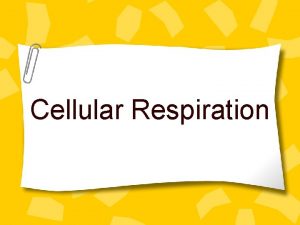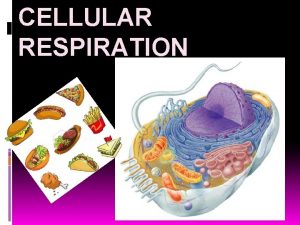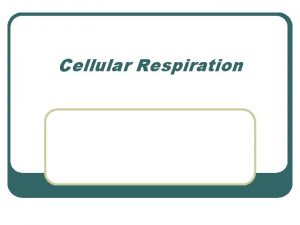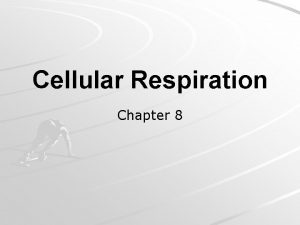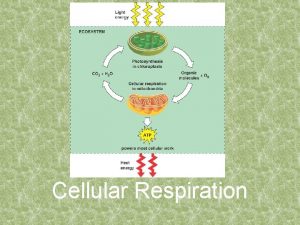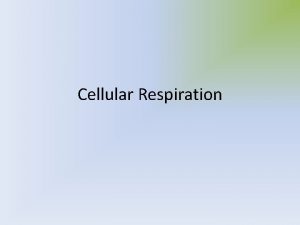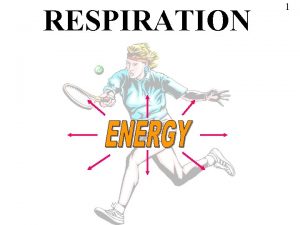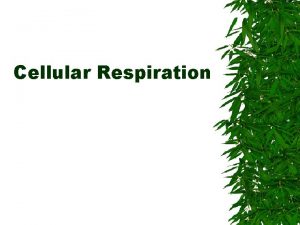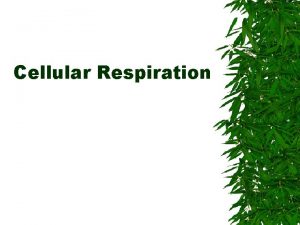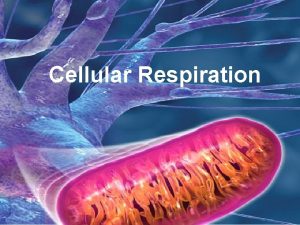7 1 Cellular Respiration 7 1 Cellular Respiration















































































- Slides: 79

7. 1 Cellular Respiration

7. 1 Cellular Respiration and why it’s cool Page 204

Cellular Respiration Glucose is the product from photosynthesis Plants store glucose in the form of starch Animals store glucose in the form of glycogen Cells need ATP for energy for particular processes

Clothespins and Muscle Fatigue Activity Get into groups Need: clothespin and timer (cell phone)

Molecules in Cellular Respiration NADH: NADH It is an electron carrier and donated electrons. NAD: NAD it accepts electrons FADH 2: electron carrier, donates electrons FAD: FAD electron carrier, accepts electrons

Glucose and ATP is not abundant in food and doesn’t provide a large amount of energy per molecule: not used for long term storage Glucose is used for long term storage: it has 100 x more energy than ATP Glucose can be converted to ATP Glucose is small and highly soluble Analogy = money

Releasing Energy is released when new bonds form Respiration The is an energy releasing process energy released is used to make ATP 36% of the energy from glucose goes into ATP, the remaining 64% is lost as heat

2 Types of Cellular Respiration 1. Aerobic cellular respiration a. b. c. 2. Needs oxygen Complete oxidation of glucose End product: CO 2, H 2 O, 36 ATP Anaerobic cellular respiration a) b) c) d) No oxygen Glucose is not oxidized Two types Both produce 2 ATP molecules

Stages Involved… 1) AEROBIC Cellular Respiration 1) Glycolysis 2) Pyruvate Oxidation 3) The Krebs Cycle 4) Electron Transport Chain & Chemiosmosis 2) ANAEROBIC Cellular Respiration 1) Glycolysis 2) Fermentation Note that both process start with Glycolysis

Cellular Respiration Reaction Summaries… 1) AEROBIC Cellular Respiration C 6 H 12 O 6 + 6 O 2 + 36 ADP + 36 Pi 6 CO 2 + 6 H 2 O + 36 ATP 2) ANAEROBIC Cellular Respiration C 6 H 12 O 6 + 2 ADP + 2 Pi 2 C 2 H 5 OH + 2 CO 2 + 2 ATP ethanol OR C 6 H 12 O 6 + 2 ADP + 2 Pi 2 C 3 H 6 O 3 + 2 CO 2 + 2 ATP lactic acid http: //www. youtube. com/watch? v=r. Ga. P 9 n. E 8 d 9 k&feature=related

7. 2 Glycolysis 1 st step in both anaerobic and aerobic cellular respiration

Energy, Cells, ATP Energy is needed in cells for many processes: need ATP Sodium potassium pumps Motion Building molecules Turning reactions on or off 1 human cells have 1 Billion ATP molecules! ATP releases energy when it is broken down into ADP and Pi

Glycolysis 2 ATP 2 ADP + 2 Pi 4 ADP + 4 Pi 4 ATP C 3 H 4 O 3 C 6 H 12 O 6 2 NAD+ 2 NADH + H+ C 3 H 4 O 3

Glycolysis Occurs in the Cell’s Cytoplasm What Cells? Plant? Animal? Bacterial?

Glycolysis is Greek for “Sugar Splitting” Glucose … which exactly describes the process C 6 H 12 O 6 Pyruvate C 3 H 4 O 3

Glycolysis The carbon “backbone” of glucose is split in half 6 -carbon sugar 3 -carbon sugar

Glycolysis Happens in both glucose Aerobicis The carbon “backbone” of and split in half Glucose 6 -carbon sugar 3 -carbon sugar Anaerobic Respiration, but is an Anaerobic Process (oxygen is not required) 3 -carbon sugar Pyruvate

Glycolysi s There are ten reactions that occur in the cytoplasm to convert Glucose into 2 Pyruvate Molecules … don’t need to know all 10 steps

Glycolysi s 2 ATP 2 ADP + 2 Pi 2 ATP molecules are used in the process

Glycolysi s 2 ATP 2 ADP + 2 Pi 4 ADP + 4 Pi 4 ATP 2 ATP molecules are used in the process 4 ATP molecules are made in the process

Glycolysi s 2 ATP 2 ADP + 2 Pi 4 ADP + 4 Pi 2 ATP molecules are used in the process 4 ATP molecules are made in the process 4 ATP = Resulting in a Net Gain of 2 ATP Molecules

Glycolysi s 2 ATP 2 ADP + 2 Pi 4 ADP + 4 Pi 2 ATP molecules are used in the process 4 ATP molecules are made in the process 4 ATP = Resulting in a Net Gain of 2 ATP Molecules (Remember that Aerobic Respiration Results in 36 ATP Total

Glycolysi s 2 ATP 2 ADP + 2 Pi 4 ADP + 4 Pi 4 ATP 2 NAD+ 2 NADH + H+ Redox Reactions also produce 2 NADH molecules and 2 H+

Glycolysi s C 6 H 12 O 6 2 ATP 2 ADP + 2 Pi 4 ADP + 4 Pi 2 NAD+ 2 NADH + H+ 4 ATP C 3 H 4 O 3 How many C, H, & O atoms are there before and after?

Glycolysi s C 6 H 12 O 6 2 ATP 2 ADP + 2 Pi 4 ADP + 4 Pi 2 NAD+ 2 NADH + H+ 4 ATP C 3 H 4 O 3 The 4 hydrogen atoms went to make 2 NADH molecules and 2 H+

2 ATP 2 ADP + 2 Pi 4 ADP + 4 Pi 4 ATP C 3 H 4 O 3 C 6 H 12 O 6 2 NAD+ 2 NADH + H+ Net Equation of Glycolysis: C 3 H 4 O 3 1 glucose + 2 ADP + 2 Pi + 2 NAD+ 2 pyruvate + 2 ATP + 2 NADH + 2 H+

Stages Involved… 1) AEROBIC Cellular Respiration 1) Glycolysis 2) Pyruvate Oxidation 3) The Krebs Cycle 4) Electron Transport Chain & Chemiosmosis 2) ANAEROBIC Cellular Respiration 1) Glycolysis 2) Fermentation Note that both process start with Glycolysis

Glycolysis Really not that efficient Only 2. 2% efficient Simple organisms use glycolysis for all their energy needs

Glucose NET ATP GAIN SO FAR - Glycolysis…………………. 2 ATP Pyruvate Acetyl Co. A Krebs Cycle TOTAL 36

7. 3 Aerobic Cellular Respiration Needs oxygen

Stages Involved… 1) AEROBIC Cellular Respiration 1) Glycolysis = Cytoplasm 2) Pyruvate Oxidation 3) The Krebs Cycle 4) Electron Transport Chain & Chemiosmosis Mitochondria VIDEO: http: //www. youtube. com/watch? v=r. Ga. P 9 n. E 8 d 9 k&feature=relate d

Mitochondria Cellular Organelles

Mitochondria à The vital organelles specialize in the production of large quantities of ATP à Composed of smooth outer membrane and highly folded inner membrane

Mitochondria The Inner Membrane… … performs many functions associated with aerobic cellular respiration … creates two compartments within the mitochondrion

Mitochondria Matrix = Fluid that fills the interior space Intermembrane Space = Fluid-filled space between the inner and outer membrane

Stages Involved… 1) AEROBIC Cellular Respiration 1) Glycolysis = Cytoplasm 2) Pyruvate Oxidation 3) The Krebs Cycle 4) Electron Transport Chain & Chemiosmosis Mitochondria

Stage 2: Pyruvate Oxidation: a chemical pathway that connects glycolysis in the Cytoplasm with the Krebs Cycle in the Mitochondrial Matrix

Stage 2: Pyruvate Oxidation Pyruvate CO 2 Once in the Mitochondria: 1) A CO 2 molecule is removed from each pyruvate (a 3 rd of the CO 2 we breathe out is comes from this!)

Stage 2: Pyruvate Oxidation Pyruvate NAD+ NADH CO 2 2) Pyruvate undergoes and oxidization reaction and NAD+ undergoes a reduction reaction And transfers high-energy H+ from Pyruvates to NAD+ molecules (a 3 rd of from this!)

Stage 2: Pyruvate Oxidation Pyruvate NAD+ NADH CO 2 Co. A Acetyl - Co. A 3) A compound called Coenzyme A (Co. A) becomes attached to the remaining 2 carbon molecule

Stage 2: Pyruvate Oxidation Pyruvate NAD+ NADH CO 2 Co. A Pyruvate Oxidation ends with the Acetyl-Co. A compound (2 Carbons and Co. A)

REMEMBER: Glycolysis makes 2 pyruvate molecules Pyruvate

REMEMBER: Glycolysis makes 2 pyruvate molecules … so this happens twice Pyruvate NAD+ NADH CO 2 NADH Co. A CO 2 Acetyl-Co. A

So Far… 2 ATP 2 ADP + 2 Pi 4 ADP + 4 Pi 4 ATP NAD+ NADH CO 2 2 NAD+ 2 NADH + H+ NADH Co. A CO 2 Co. A Glycolysis in the Cytoplasm Pyruvate Oxidation in the Mitochondrial

Stage 3: The Krebs Cycle Co. A An 8 step cyclic series of reactions that… … transfers energy from organic molecules to ATP, NADH, and FADH 2 … removes carbon atoms as CO 2 We will not be going over the 8 steps

Stage 3: The Krebs Cycle Co. A Is Cyclic, because…. One of the products of the 8 th step is a reactant for step 1

Stage 3: The Krebs Cycle Co. A As Acetyl-Co. A enters the cycle, Co. A is released (can go back to Pyruvate Oxidation step)

Stage 3: The Krebs Cycle Co. A Two CO 2 molecules are released 2 CO 2

Stage 3: The Krebs Cycle Co. A NA NA DH 3 NAD+ molecules are reduced to form 3 NADH 2 CO 2 D+ 2 N ADH

Stage 3: The Krebs Cycle Co. A NA DH NA D+ 1 FAD molecule is reduced to form 1 FADH 2 2 CO 2 2 N H 2 D FA D A F AD + 2 N ADH

Stage 3: The Krebs Cycle Co. A NA ADP and Pi combine to form 1 ATP molecule 2 CO 2 DH NA D+ 2 N H 2 D FA D A F AD + 2 N ADH ATP ADP + Pi

So, from 1 Glucose Molecule…

So, from 1 Glucose Molecule… 2 ATP 2 ADP + 2 Pi Stage 1: Glycolysis 2 NAD+ 2 NADH + H+ 4 ADP + 4 Pi 4 ATP NAD+ CO 2 NADH Co. A NA DH NA D Co. A 2 CO 2 NA 2 CO 2 DH NA D+ + 2 N 2 N AD + DH 2 FA D FA Stage 2: Pyruvate Oxidation CO 2 2 N ADH ATP ADP + Pi AD + 2 N DH 2 ADH FA D FA ATP ADP + Pi Stage 3: The Krebs Cycle

NET ATP GAIN SO FAR Glucose - Glycolysis…………………. - 2 ATP - 2 NADH Pyruvate - 2 NADH Acetyl Co. A Krebs Cycle - 6 NADH - 2 FADH 2 - 2 ATP………………. 2 ATP TOTAL 36 ATP

NET ATP GAIN SO FAR Glucose - Glycolysis…………………. 2 ATP - 2 NADH Pyruvate - 2 NADH Acetyl Co. A Krebs Cycle Still need to make 32 ATP m olecules !! - 6 NADH - 2 FADH 2 - 2 ATP………………. 2 ATP TOTAL 36 ATP

Stage 4: Electron Transport & Chemiosmosis The NADH and FADH 2 eventually move from the Matrix to the Inner Mitochondrial Membrane

Stage 4: Electron Transport & Chemiosmosis The NADH and FADH 2 eventually move from the Matrix to the Inner Mitochondrial Membrane Intermembrane Space Inner Membrane Matrix NADH

Stage 4: Electron Transport & Chemiosmosis The NADH and FADH 2 eventually move from the Matrix to the Inner Mitochondrial Membrane … where they undergo oxidization reactions, giving up 2 high-energy electrons 2 e- NADH NAD+

Stage 4: Electron Transport & Chemiosmosis As the electrons make there way from carrier molecule to carrier molecule, they release energy 2 e-

Stage 4: Electron Transport & Chemiosmosis As the electrons make there way from carrier molecule to carrier molecule, they release energy … which is used to push H+ across the membrane H+ H+ H+ 2 e. H+ H+ H+

Stage 4: Electron Transport & Chemiosmosis After going through the last Carrier Molecule, the 2 lowenergy electrons combine with oxygen and 2 H+ … Forming Water H+ H+ H+ 2 e 2 H+ + O H 2 O

Stage 4: Electron Transport & Chemiosmosis FADH 2 from the Krebs Cycle undergoes the same process, but it drops off its electrons at a different carrier molecule and FADH 2 has lower energy = not as many H+ ions can cross H+ H+ H+ 2 e- NADH NAD+ H+ H+

Stage 4: Electron Transport & Chemiosmosis STILL HAVEN`T MADE ANY MORE ATP MOLECULES!! H+ H+ H+ 2 e. H+ H+

Stage 4: Electron Transport & Chemiosmosis JUST LIKE IN PHOTOSYNTHESIS, H+ IONS QUICKLY PASS THROUGH ATP SYNTHASE, GIVING OFF THE ENERGY NEEDED TO MAKE ATP H+ H+ H+ H+ ADP + Pi ATP

Stage 4: Electron Transport & Chemiosmosis Oxidative ATP synthase: synthase production of ATP through oxidation reactions H+ H+ H+ 2 e- NADH NAD+ 2 H + + O H O H+ H+ H+ ADP + Pi ATP

SUMMARY OF AEROBIC CELLULAR ESPIRATION Step 1: Glycolysis 2 ATP 2 ADP + 2 Pi 2 NAD+ 2 NADH + H+ 4 ADP + 4 Pi 4 ATP Step 4: Electron Transpo and Chemiosmos Step 2: Pyruvate Oxidation NAD+ CO 2 NADH CO 2 H H+ Co. A + H+ H+ H H+ + + H+ H H NA D+ Co. A 2 CO 2 NA 2 CO 2 DH NA D+ 2 N 2 N AD + 2 N DH 2 ADH FA D FA ATP ADP + Pi 2 N DH 2 ADH FA D FA H+ + H H+ Co. A + ATP ADP + Pi Step 3: Krebs Cycle H+ ATP

Aerobic Balance Sheet

7. 4 Anaerobic Cellular Respiration NO OXYGEN Starts with glycolysis just like aerobic respiration

Anaerobic Cellular Respiration To re-form NAD+ anaerobic respiration involves transferring the hydrogen atoms of NADH to certain organic molecules … this process is called Fermentation

Stages Involved… 1) AEROBIC Cellular Respiration 1) Glycolysis 2) Pyruvate Oxidation 3) The Krebs Cycle 4) Electron Transport Chain & Chemiosmosis 2) ANAEROBIC Cellular Respiration 1) Glycolysis 2) Fermentation

Anaerobic Cellular Respiration Fermentation àBacteria have evolved many forms àEukaryotes primarily use 2 methods: 1) Alcohol Fermentation 2) Lactic Acid Fermentation

Pyruvate CO 2 A carbon dioxide molecule is removed from the pyruvate by the pyruvate decarboxylase enzyme to form acetaldehyde Alcohol Fermentation

Pyruvate CO 2 The Acetaldehyde molecule gains electrons and hydrogen from NADH to form Ethanol The resulting NAD+ can be used for glycolysis Acetaldehyde NADH NAD+ Ethanol Alcohol Fermentation


Alcohol Fermentation C 6 H 12 O 6 + 2 ADP + 2 Pi 2 C 2 H 5 OH + 2 CO 2 + 2 ATP ethanol The 2 ATP molecules that these alcohol-fermenting organisms produce is enough to satisfy their energy needs. The CO 2 and ethanol are expelled as waste products

Under normal conditions, animals obtain energy from AEROBIC RESPIRATION; however, during strenuous exercise, muscles demand more ATP than it can produce

Under normal conditions, animals obtain energy from AEROBIC RESPIRATION; however, during strenuous exercise, muscles demand more ATP than it can produce Under these conditions, additional ATP molecules are supplied by Lactic Acid Fermentation

Pyruvate NADH NAD+ Lactic Acid Fermentation NADH transfers its hydrogen atoms to pyruvate in the cytoplasm, forming Lactic Acid The resulting NAD+ can be used for glycolysis Lactic Acid

Lactic Acid Fermentation C 6 H 12 O 6 + 2 ADP + 2 Pi 2 C 3 H 6 O 3 + 2 ATP Lactic Acid The accumulation of lactic acid in muscles causes stiffness, soreness and fatigue When vigorous exercise ends, lactic acid is converted back to pyruvate, which can undergo the remaining stages of aerobic respiration
 Cellular respiration releases
Cellular respiration releases Aerobic respiration exercise
Aerobic respiration exercise Cellular respiration organelle
Cellular respiration organelle Section 3 cellular respiration continued
Section 3 cellular respiration continued Concept 5 cellular respiration
Concept 5 cellular respiration Cellular respiration
Cellular respiration What happens during glycolysis
What happens during glycolysis Cellular respiration is the opposite of
Cellular respiration is the opposite of Cellular respiration fact
Cellular respiration fact Aerobic respiration
Aerobic respiration Definition of fermentation
Definition of fermentation Cellular respiration
Cellular respiration What is the chemical formula of cellular respiration
What is the chemical formula of cellular respiration What is produced in cellular respiration
What is produced in cellular respiration Aerobic cellular respiration
Aerobic cellular respiration Coenzymes in cellular respiration
Coenzymes in cellular respiration Where does cellular respiration take place
Where does cellular respiration take place Total atp produced in cellular respiration
Total atp produced in cellular respiration Where in the cell does cellular respiration occur
Where in the cell does cellular respiration occur Chapter 9 cellular respiration harvesting chemical energy
Chapter 9 cellular respiration harvesting chemical energy Cellular respiration
Cellular respiration Higher human biology cellular respiration
Higher human biology cellular respiration Labeled mitochondria cellular respiration
Labeled mitochondria cellular respiration Cellular respiration equation
Cellular respiration equation Cellular respiration reactants
Cellular respiration reactants Cellular respiration respiratory system
Cellular respiration respiratory system Where does cellular respiration take place
Where does cellular respiration take place Is oxygen needed as a reactant in the krebs cycle
Is oxygen needed as a reactant in the krebs cycle What is the correct equation for cellular respiration?
What is the correct equation for cellular respiration? Function of cellular respiration
Function of cellular respiration Crash course electron transport chain
Crash course electron transport chain Cellular respiration harvesting chemical energy
Cellular respiration harvesting chemical energy Overall reaction of cellular respiration
Overall reaction of cellular respiration Section 3 cellular respiration worksheet answers
Section 3 cellular respiration worksheet answers Starting materials for cellular respiration
Starting materials for cellular respiration Cellular respiration
Cellular respiration Cellular respiration modle
Cellular respiration modle Total atp produced in cellular respiration
Total atp produced in cellular respiration Chapter 9: cellular respiration: harvesting chemical energy
Chapter 9: cellular respiration: harvesting chemical energy Overview of cellular respiration
Overview of cellular respiration Section 3 cellular respiration
Section 3 cellular respiration Atp formula cellular respiration
Atp formula cellular respiration Road map for cellular respiration
Road map for cellular respiration Where in the cell does cellular respiration occur
Where in the cell does cellular respiration occur Why is cellular respiration important
Why is cellular respiration important Electron carriers in cellular respiration
Electron carriers in cellular respiration Function of cellular respiration
Function of cellular respiration What type of cell performs cellular respiration
What type of cell performs cellular respiration Cellular respiration ap biology
Cellular respiration ap biology Electron transport chain cellular respiration
Electron transport chain cellular respiration Which organism is an autotroph
Which organism is an autotroph Role of cellular respiration
Role of cellular respiration Chapter 9: cellular respiration: harvesting chemical energy
Chapter 9: cellular respiration: harvesting chemical energy Cellular respiration
Cellular respiration Photosynthesis and cellular respiration jeopardy
Photosynthesis and cellular respiration jeopardy Energy flow in cellular respiration
Energy flow in cellular respiration Photosynthesis word equation
Photosynthesis word equation Mitochondrion
Mitochondrion Cellular respiration foldable
Cellular respiration foldable Cellular respiration equation
Cellular respiration equation Photosynthesis equation.
Photosynthesis equation. External respiration process
External respiration process Cellular respiration equation
Cellular respiration equation Chemiosmosis steps
Chemiosmosis steps Snails and elodea virtual lab
Snails and elodea virtual lab Cellular respiration ap biology
Cellular respiration ap biology Cellular respiration occurs in
Cellular respiration occurs in Steps 1
Steps 1 Section 3 cellular respiration
Section 3 cellular respiration Chapter 8 section 3 cellular respiration continued
Chapter 8 section 3 cellular respiration continued Respiration
Respiration Lab bench cellular respiration
Lab bench cellular respiration Cellular respiration pearson
Cellular respiration pearson Overview of respiration
Overview of respiration Cellular respiration
Cellular respiration Functions of cellular respiration
Functions of cellular respiration Cellular respiration goal
Cellular respiration goal Cellular respiration table
Cellular respiration table Section 7-1 glycolysis and fermentation answer key
Section 7-1 glycolysis and fermentation answer key Complimentary processes
Complimentary processes
